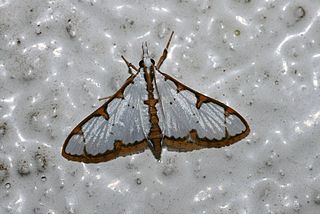Related Research Articles

Erebus is a genus of moths in the family Erebidae.

Sandava xylistis, the rusty snout, is a moth of the family Erebidae first described by Charles Swinhoe in 1900. It is found in the Australian states of Victoria and Queensland, New South Wales, Tasmania, South Australia and the Australian Capital Territory.

Cirrhochrista is a genus of moths of the family Crambidae described by Julius Lederer in 1863.

Thliptoceras is a genus of moths of the family Crambidae. The genus was erected by William Warren in 1890.
Abriesa is a monotypic moth genus of the family Erebidae. Its only species, Abriesa derna, is found in Queensland, Australia. Both the genus and the species were first described by Charles Swinhoe in 1900.

Adrapsa is a genus of moths of the family Erebidae. It was erected by Francis Walker in 1859.
Mecodina is a genus of moths of the family Erebidae first described by Achille Guenée in 1852.

Sandava is a genus of moths of the family Erebidae. The genus was erected by Francis Walker in 1863.

Visiana is a genus of moths in the family Geometridae described by Charles Swinhoe in 1900.
Grammodes cooma is a moth of the family Noctuidae first described by Charles Swinhoe in 1900. It is known from the Australian state of Queensland and the Indonesia's Ambon Island.

Cirrhochrista etiennei is a moth of the family Crambidae. It was described by Pierre Viette in 1975 and it is endemic to Réunion.

Cirrhochrista brizoalis is a moth of the family Crambidae described by Francis Walker in 1859. It is found across south and south-east Asia from India to Taiwan and in New Guinea and Australia.

Nyctemera luctuosa is a moth of the family Erebidae first described by Samuel Constantinus Snellen van Vollenhoven in 1863. It is found in Papua New Guinea, Australia and the Philippines. The habitat consists of mountainous areas.
Utetheisa aegrotum is a moth in the family Erebidae. It was described by Charles Swinhoe in 1892. It is found in Australia, where it has been recorded from Queensland and New South Wales.
Cirrhochrista annulifera is a moth in the family Crambidae. It is found in Papua New Guinea, on the D'Entrecasteaux Islands and in Australia, where it has been recorded from Western Australia, the Northern Territory and Queensland.

Cirrhochrista arcusalis is a moth in the family Crambidae. It is found in Australia, where it has been recorded from coastal Queensland and New South Wales.
Cirrhochrista cyclophora is a moth in the family Crambidae. It was described by Oswald Bertram Lower in 1903 and it is found in Australia.
Cirrhochrista punctulata is a moth in the family Crambidae. It was described by George Hampson in 1896. It is found in Australia, where it has been recorded from Queensland. It is mostly found in the mesophyll rainforest on Cape York in the Alexandra Range, Cape Tribulation and the Iron Range.
Cirrhochrista minuta is a moth in the family Crambidae first described by Charles Swinhoe in 1902. It is found in Malaysia.

Margaroniini is a tribe of the species-rich subfamily Spilomelinae in the pyraloid moth family Crambidae. The tribe was erected by Charles Swinhoe and Everard Charles Cotes in 1889.
References
- ↑ Nuss, M.; et al. (2003–2014). "GlobIZ search". Global Information System on Pyraloidea. Retrieved 15 July 2014.
- ↑ Herbison-Evans, Don & Crossley, Stella (2 September 2019). "Cirrhochrista caconalis Swinhoe, 1900". Australian Caterpillars and their Butterflies and Moths. Retrieved 18 April 2020.
| This Margaroniini-related article is a stub. You can help Wikipedia by expanding it. |